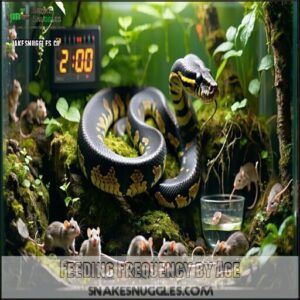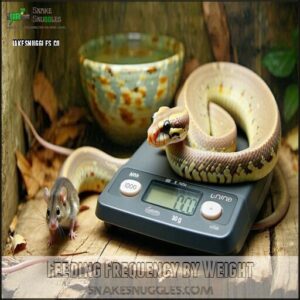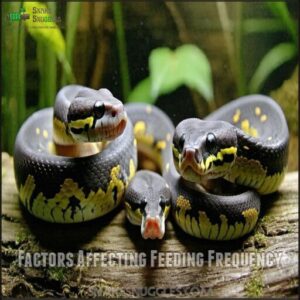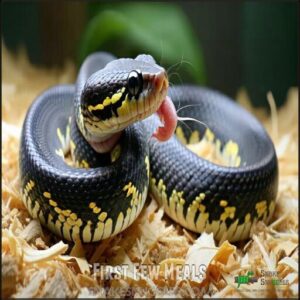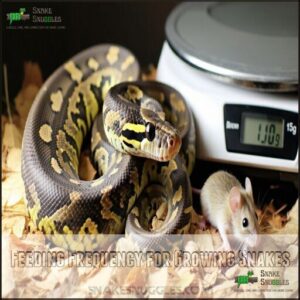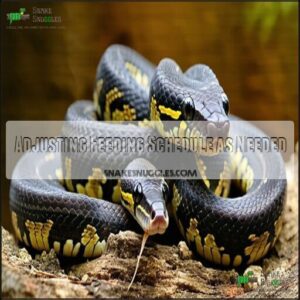This site is supported by our readers. We may earn a commission, at no cost to you, if you purchase through links.

These young snakes have faster metabolisms than adults, requiring more frequent meals to support healthy growth. Offer appropriately sized prey—typically pinky or fuzzy mice—that’s about 10-15% of your snake’s body weight.
As your scaly friend grows, you’ll gradually extend the time between feedings and increase prey size.
Watch your python’s body condition; a healthy snake should feel firm but not bony or overly plump. Proper feeding isn’t just about frequency; temperature, environment and feeding techniques all play vital roles in your baby ball python‘s development and well-being.
Table Of Contents
- Key Takeaways
- Baby Ball Python Feeding Basics
- How Often to Feed Baby Ball Pythons
- Feeding Schedule for Baby Ball Pythons
- Common Feeding Mistakes and Challenges
- Monitoring and Adjusting Feeding Habits
- Frequently Asked Questions (FAQs)
- How often should I feed a ball python baby?
- Can you overfeed a baby ball python?
- How do I know if my baby ball python is hungry?
- How often should you feed a ball python?
- Can you feed a baby Python too often?
- How long can a ball python go off feed?
- Do ball pythons need to be fed?
- Do ball pythons eat at night?
- How big should a ball python eat?
- How often should I feed a baby ball python?
- Conclusion
Key Takeaways
- Feed your baby ball python every 5-7 days, offering prey that’s about 10-15% of its body weight.
- Choose prey no larger than the width of your snake’s midsection for safe and stress-free feeding.
- Maintain proper habitat temperatures (85-90°F warm side) and keep the environment calm during feeding.
- Watch for signs like firm muscle tone and regular shedding to confirm your snake’s health is on track.
Baby Ball Python Feeding Basics
You’ll need to establish proper feeding habits early to guarantee your baby ball python grows healthy and strong.
Feeding hatchlings every 5-7 days with appropriately sized prey items (typically pinky mice) will provide the nutrition they need while mimicking their natural feeding patterns, which is crucial for them to grow healthy.
Nutritional Requirements
Your baby ball python thrives on a precise nutritional balance as an obligate carnivore. They require whole prey animals that provide complete nutrition, with items ideally measuring about 10% of their body weight.
Whole prey animals measuring 10% of body weight deliver perfect nutrition for your ball python’s carnivorous needs.
Commercial feeders sometimes lack vitamin D, so occasional calcium supplementation benefits your snake’s development. Proper hydration is essential, so always provide fresh water.
A well-planned diet supports healthy growth patterns, while consistent feeding schedules maintain digestive health. Unlike other pets, ball pythons don’t need variety – they need appropriate-sized prey offered at the right frequency to meet their unique dietary requirements.
Prey Selection and Size
Selecting the right prey is critical for your baby ball python’s health. Now, let’s focus on what and how to feed them.
Choose prey that matches your snake’s midsection width. For most hatchlings, pinky mice are perfect starters. You can find a variety of pinky mouse products online.
- Finding the right prey size creates a confident, stress-free python
- Properly sized meals prevent regurgitation and digestive issues
- Watching your snake successfully eat builds owner satisfaction
- Consistent feeding develops trust between you and your pet
- Appropriate prey selection guarantees healthy growth patterns
As your python grows, gradually increase from pinky mice to fuzzy rats, always maintaining the 1-1.25x size ratio to your snake’s widest point. This approach ensures a stress-free feeding experience and supports the overall well-being of your pet.
Feeding Environment and Temperature
Creating the ideal feeding environment for your ball python requires careful temperature control. Your snake’s habitat should maintain a proper thermal gradient with the following specifications:
| Zone | Temperature | Importance |
|---|---|---|
| Cool side | 75-80°F | Digestion regulation |
| Warm side | 87-90°F | Activity stimulation |
| Basking spot | 90-92°F | Feeding response |
| Nighttime | 72-75°F | Rest period |
| Feeding area | 85-88°F | Appetite trigger |
Maintain humidity between 55-60% and provide a quiet environment with dim lighting to reduce stress during feeding times.
Precise temperature control is often achieved using a reptile habitat thermostat.
Importance of Proper Feeding Techniques
Now that you’ve got your temperature settings right, let’s talk about how you’ll actually serve dinner to your new pet.
Proper feeding techniques make all the difference in your baby ball python’s mealtime success. Using the right methods guarantees your snake stays healthy and stress-free during feedings.
- Never thaw prey in a microwave—instead, use room temperature water for safe, even thawing techniques.
- Always use feeding tongs (12-18 inches long) for safe handling, keeping your fingers away from potential strikes.
- Practice cage feeding rather than moving your python to a separate container, which reduces stress.
After feeding, leave your snake undisturbed for 48 hours—this critical post-feed handling rule prevents regurgitation.
How Often to Feed Baby Ball Pythons
You’ll need to feed your baby ball python every 5-7 days during its first six months of life.
As your snake grows, you can adjust this schedule based on its weight and development, gradually extending the time between meals.
Feeding Frequency by Age
Now that you understand the basics, let’s focus on how feeding schedules change as your baby ball python grows.
Your python’s age directly impacts how often they need to eat. Following the right feeding frequency guarantees proper development without overfeeding.
Here’s a straightforward age-based feeding timeline:
- Hatchling feeding (0-3 months): Feed every 5 days to support rapid initial growth
- Young juveniles (3-6 months): Offer food every 5-7 days as growth continues
- Older juveniles (6-12 months): Shift to every 7-10 days
- Yearlings (12-18 months): Feed every 10-14 days as growth begins to slow
- Sub-adults (18+ months): Continue with 10-14 day intervals, adjusting based on seasonal changes
Remember that individual pythons may have slightly different needs. Monitor your snake’s body condition to determine if your feeding schedule requires adjustment. Prey size should be approximately ten percent of weight.
Feeding Frequency by Weight
While age offers a starting point for feeding schedules, your baby ball python’s weight provides a more precise guide.
For accurate weight-based schedules, the following table outlines the recommended feeding frequency and prey size based on the snake’s weight:
| Weight (grams) | Feeding Frequency | Prey Size |
|---|---|---|
| 100-300 | Every 5-7 days | Fuzzy mouse/rat |
| 300-700 | Every 7 days | Small rat |
| 700-1000 | Every 10-14 days | Small/medium rat |
| 1000-1500 | Every 7-10 days | Medium rat |
| 1500+ | Every 10-21 days | Medium/large rat |
Always aim for prey that’s 7-15% of your snake’s body weight to maintain healthy growth without obesity risk.
Factors Affecting Feeding Frequency
Determining your baby ball python’s feeding frequency involves several variables beyond just weight.
Metabolic rate varies between individuals, affecting how quickly they digest meals.
Environmental temperature plays a vital role—cooler enclosures slow digestion dramatically.
- A ball python entering its shedding cycle will typically refuse food until the process completes.
Activity level and growth rate also influence hunger; more active snakes may need slightly more frequent meals.
Individual variation means some pythons naturally eat less often while maintaining healthy weight.
During seasonal changes, baby ball python feeding patterns may shift, requiring you to adjust the feeding frequency accordingly, considering the metabolic rate and overall environmental temperature.
Signs of Proper Feeding Frequency
Knowing your baby ball python is on the right feeding schedule comes down to watching for key health indicators.
Your python will show clear signs when its nutritional needs are being met properly.
| Indicator | Healthy Sign | Warning Sign |
|---|---|---|
| Weight | Steady gain | Rapid gain or loss |
| Shedding | Regular, complete | Stuck shed, irregular |
| Behavior | Alert, active | Lethargic or overly aggressive |
Watch for feeding cues like increased movement and tongue flicking. A well-fed python will have good muscle-tone, regular bowel movements, and consistent appetite signals.
Adjust your python feeding frequency if you notice any concerning changes in these patterns.
Feeding Schedule for Baby Ball Pythons
You’ll need to feed your baby ball python every 5-7 days during their first six months of life.
As they grow, you can gradually space out meals to every 7-10 days, always matching the prey size to approximately 10-15% of your snake’s body weight, which is a crucial factor in their development and health, particularly in relation to their body weight.
First Few Meals
For your baby ball python’s first few meals, timing is vital for successful feeding. Offer the initial prey within the first evening after arrival to reduce stress.
- Live rat fuzzies mimic natural diet and trigger strong feeding responses
- Frozen-thawed options work if the prey is properly warmed to 100-105°F
- Attempt feeding for just 45 seconds to avoid stressing your hatchling
- If rejected, wait five days before trying again—not daily!
Most healthy hatchlings eat enthusiastically within 2 days after their first shed. Successful feeding is crucial for their development.
Feeding Frequency for Hatchlings
Now that your hatchling has finished absorbing its yolk sac, it’s time to establish a regular feeding routine.
For ideal hatchling metabolism and growth rate, follow these guidelines:
- Feed your baby ball python every 5 days consistently
- Select pinky mice smaller than the snake’s midsection (1-1.25x girth)
- Monitor weight gain after each meal
- Adjust timing if you notice shedding impact on appetite
Erratic feeding occasionally mimics natural patterns, but consistency helps track newborn python feeding progress. Hatchlings typically require hopper mice initially for proper growth. Consistency is key to understanding feeding progress and making necessary adjustments.
Feeding Frequency for Growing Snakes
As your snake continues to grow, its feeding frequency will gradually change.
Growing ball pythons typically need meals every 7-10 days, with prey size matching their widest body section.
Your baby ball python’s feeding schedule should follow this pattern:
| Age (Months) | Feed Frequency | Prey Size | Meal Weight | Notes |
|---|---|---|---|---|
| 3-6 | 7 days | Hopper Mouse | 10-20g | Active growth |
| 6-12 | 7-10 days | Fuzzy Rat | 20-30g | Steady pace |
| 12-18 | 10 days | Small Rat | 30-50g | Monitor weight |
Individual variation is normal—some snakes have faster metabolic needs than others, and it’s essential to monitor their growth and adjust the feeding schedule accordingly to ensure steady pace and active growth, while also considering their meal weight and overall health to prevent issues.
Adjusting Feeding Schedule as Needed
As your ball python grows, its feeding schedule should evolve accordingly.
Regular weight monitoring is essential for proper adjustments to your python feeding schedule.
Watch for these key indicators:
- Growth Spurts – Increase feeding frequency slightly during rapid development phases
- Shedding Cycle – Expect reduced appetite before and during shed; resume normal schedule afterward
- Seasonal Changes – Some pythons naturally eat less during winter months
Individual metabolism varies among snakes, so adjust baby ball python feeding based on your pet’s unique patterns.
If your snake consistently refuses meals or shows dramatic changes in ball python feeding frequency, consult a reptile veterinarian promptly.
Common Feeding Mistakes and Challenges
You’ll face several challenges when feeding your baby ball python, from determining the right prey size to handling feeding refusals.
Even experienced keepers make mistakes with feeding schedules, which can impact your snake’s health and growth.
Overfeeding and Underfeeding
Now that you’ve established a feeding schedule, let’s address a common concern: finding the right balance at mealtime.
Overfeeding creates obesity risks in your baby ball python, leading to regurgitation signs and lethargy. Underfeeding causes growth stunting and weakness.
The key is proper weight monitoring and appropriate prey size. Overfeeding can also lead to digestive issues and bloating, so it’s important to be vigilant.
| Feeding Issue | Warning Signs | Prevention |
|---|---|---|
| Overfeeding | Bulging body, regurgitation | Follow feeding frequency chart |
| Balanced Diet | Steady growth, active behavior | Prey 1-1.25× midsection width |
| Underfeeding | Prominent spine, slow growth | Weigh monthly, adjust as needed |
Refusal to Eat and Loss of Appetite
While overfeeding creates obvious problems, a baby ball python refusing food presents more subtle challenges.
Food refusal often stems from several factors that disrupt your python’s normal appetite:
- Stress Factors: Recent handling, enclosure changes, or excessive noise can trigger food avoidance
- Shedding Cycle: Most pythons naturally fast during the pre-shed "blue" phase
- Incorrect Temperatures: Keeping the enclosure below 87-90°F on the warm side impairs digestion
- Underlying Illnesses: Respiratory infections or parasites may cause prolonged hunger strikes
Monitor your python’s weight during periods of refusal. A healthy snake can go 2-3 weeks without eating, but substantial weight loss (over 10%) warrants veterinary attention.
Always make certain prey size matches your snake’s midsection diameter and maintain proper environmental conditions before jumping to conclusions about appetite problems.
Tips for Overcoming Feeding Challenges
When your baby ball python refuses meals, don’t panic. After identifying appetite issues, try these proven solutions:
Warm prey items to 100-105°F using warm water—never microwave. This mimics natural body heat that triggers feeding responses.
Warming prey to 100-105°F mimics natural body heat, igniting your python’s instinctual feeding response.
Try these appetite stimulation techniques:
- Scenting techniques: Rub prey with bedding from mice
- Color preference: Offer different colored prey (white vs. brown)
- Feeding tricks: Use tongs to create realistic "hunting" movements
Ensure the environment is quiet, dark, and stress-free during feeding attempts. Many owners successfully use frozen mice options for their snakes.
With patience and consistency, most feeding challenges resolve naturally.
Monitoring and Adjusting Feeding Habits
You’ll need to regularly track your baby ball python’s weight, feeding response, and overall behavior to confirm their feeding schedule remains appropriate.
As your snake grows, you’ll adjust both prey size and feeding frequency based on these observations, typically shifting from every 5-7 days for hatchlings to less frequent feedings as they mature, which helps confirm the feeding schedule remains appropriate.
Signs of Healthy Growth and Development
Now that you’ve learned to avoid feeding mistakes, watching for positive growth signs becomes your next priority.
Your baby ball python shows healthy weight gain when scales look smooth and muscle tone develops properly.
Regular defecation (every 5-7 days) indicates good digestion, while consistent shedding cycles demonstrate proper growth rate.
Active periods during evening hours suggest normal activity levels, though ball pythons naturally spend time hiding.
Track your snake’s weight weekly—steady 10-15% monthly increases confirm your feeding frequency is supporting ideal snake growth and development.
Recognizing Signs of Stress or Illness
While monitoring your snake’s healthy growth patterns, don’t overlook potential trouble signs.
Your baby ball python’s behavior speaks volumes about its health.
Watch for these warning signals:
- Lethargy signs like unusual daytime activity or excessive hiding
- Shedding issues including stuck shed or incomplete shedding
- Regurgitation risks after feeding
- Weight loss despite normal feeding frequency
- Appetite changes or food refusal lasting more than 2-3 weeks
These indicators often signal stress or illness requiring prompt attention, as they can be signs of underlying health issues that need to be addressed to ensure the healthy growth of your pet, and prevent potential regurgitation risks.
Adjusting Feeding Schedule Based on Observations
Like a skilled detective, you’ll need to adjust your baby ball python’s feeding schedule based on careful observations.
Watch for behavioral cues—increased tongue flicking or actively tracking movement often signals hunger. Regular weight monitoring provides concrete evidence of proper nutrition, with steady growth confirming your feeding frequency is appropriate.
After shedding cycles, your python’s appetite typically increases, making this an ideal time to offer food. If your snake appears underweight or overly keen between meals, consider shortening feeding intervals or increasing prey size slightly.
Conversely, regurgitation signs warn you’re feeding too frequently or offering oversized prey. During growth spurts, you’ll notice increased hunger and faster weight gain, requiring temporary schedule adjustments.
The perfect python feeding schedule evolves with your pet’s changing needs—their activity levels, weight trends, and feeding response will guide your decisions better than any calendar.
Seeking Professional Advice When Needed
While monitoring your snake’s progress, sometimes you’ll need a professional opinion. Don’t hesitate to seek help from reptile specialists when:
- Your baby ball python refuses multiple consecutive meals
- You notice significant weight loss (more than 10% of body weight)
- Abnormal behavior persists after feeding schedule adjustments
- Regurgitation occurs more than once
Veterinarian consultation is particularly important for new owners unfamiliar with python feeding frequency. Remember that essential nutrients for reptiles are indispensable for their health.
Expert breeders and herpetological societies offer valuable guidance, but nothing replaces a qualified vet who specializes in exotic pets. Online forums can provide support between appointments, connecting you with experienced python keepers, and offering a source of essential advice for reptile care and snake health.
Frequently Asked Questions (FAQs)
How often should I feed a ball python baby?
Think of your baby ball python’s feeding schedule like clockwork: feed it every 5-7 days.
Offer prey appropriately sized to its girth—usually pinky or fuzzy mice—ensuring consistent nutrition for healthy growth and development.
Can you overfeed a baby ball python?
Yes, you can overfeed a baby ball python.
Offering food too frequently or prey that’s too large can lead to obesity, digestive problems, or stress.
Stick to an appropriate feeding schedule and prey size.
How do I know if my baby ball python is hungry?
Your baby ball python might be hungry if it becomes more active, explores its enclosure, or shows interest when you approach.
Look for tongue-flicking near prey or restlessness, especially during its usual feeding time.
How often should you feed a ball python?
Feeding a ball python is like planning a balanced schedule—young ones eat every 5-7 days, juveniles every 7-14 days, and adults every 10-14 days.
Adjust timing to your snake’s size and age.
Can you feed a baby Python too often?
Overfeeding a baby ball python can stress its digestive system, leading to regurgitation or obesity.
Stick to a proper schedule, feeding every 5-7 days, and always use prey appropriately sized for your snake’s midsection.
How long can a ball python go off feed?
Ball pythons can go months without eating, sometimes up to 5 years in extreme cases.
However, prolonged fasting isn’t healthy.
Monitor their weight, make certain proper enclosure conditions, and consult a vet if fasting continues.
Do ball pythons need to be fed?
Proper prey portions promote python health.
Yes, they need feeding, as they’re carnivores thriving on mice or rats.
Offer them properly sized meals, ensuring they’re thawed and warmed.
Regular feeding aligns with their natural hunting habits.
Do ball pythons eat at night?
Yes, ball pythons are naturally nocturnal hunters, so they prefer eating at night.
Offering food after sunset aligns with their instincts and increases the chances they’ll strike and eat without hesitation.
How big should a ball python eat?
Regarding feeding your snake, keep it simple: their meal should be 1 to 25 times the snake’s midsection girth. Smaller prey works too, but avoid oversized meals to prevent health issues.
How often should I feed a baby ball python?
You should feed baby ball pythons every 5-7 days to support their growth.
Use prey the size of the snake’s midsection, and avoid feeding too often to prevent health issues like regurgitation.
Conclusion
Figuring out how often baby ball pythons should be fed is essential for their growth and health.
Stick to feeding them every 5-7 days with prey that’s 10-15% of their body weight.
Monitor their condition—firm, not bony or overweight—and adjust as they grow.
Create a calm feeding environment and watch for signs of stress or changes in appetite.
With the right care, your baby ball python will thrive and move smoothly to an adult feeding schedule.


